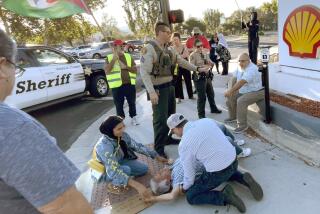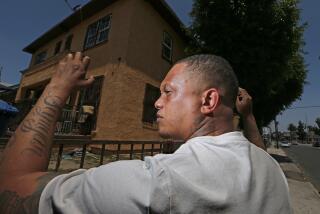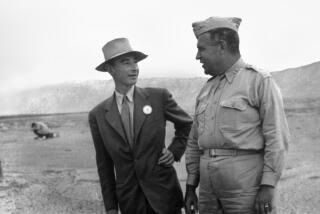Blood Loss Quickly Immobilized Cooperman, Expert Says
- Share via
A pathologist testified Wednesday that slain Cal State Fullerton physicist Edward Lee Cooperman could not have been conscious for more than 10 to 30 seconds after he was fatally shot in his office last October.
The prosecution hopes to show that defendant Minh Van Lam’s version of what happened in the professor’s campus office --that Lam accidentally shot Cooperman when the professor grabbed his arm to show him how to aim the gun--does not explain the fact that Cooperman’s blood was found on opposite walls, his file cabinet and his desk, which was scattered with papers.
Lam, 21, is on trial for murder in Orange County Superior Court. The 48-year-old professor died of a single gunshot wound on Oct. 13, 1984.
Lam had told police that after the shooting he and Cooperman spoke to each other, then he helped Cooperman to the floor. Lam said he left the office briefly, came back to get his jacket and left again. His defense is that Cooperman must have gotten up from the floor on his own after Lam had left the first time, leaving the blood marks and scattering the papers.
But Dr. Richard I. Fukimoto, a private pathologist who performed the autopsy on Cooperman’s body for the county coroner’s office, testified emphatically that Cooperman could not have gotten up more than 30 seconds after the shooting because of a tremendous loss of blood.
Lam, a former student of Cooperman and a Vietnamese refugee, was arrested a few hours after he reported finding the professor’s body. He said the .25-caliber handgun that fired the fatal shot through the left side of Cooperman’s neck went off by accident.
Cooperman was internationally known for his scientific and humanitarian aid to the Communist regime in Vietnam.
Cooperman’s friends have said he told them for several months that he had received death threats, convincing them he was the victim of a political assassination. But the prosecution so far has not produced any evidence to substantiate that theory.
Both sides seek to explain how the professor’s office became disheveled.
Deputy Dist. Atty. Mel Jensen opened his case Monday and so far has not provided the jury with any theories on what Lam’s motive for murder might have been. Jensen is expected to close his case today, after just four days of testimony.
Jensen’s two key pieces of evidence so far have been Lam’s own taped statements to police about what happened and Fukimoto’s testimony.
On Tuesday, jurors watched videotapes that showed Lam telling Fullerton police that the shooting was an accident.
At Lam’s preliminary hearing last November, Fukimoto said Cooperman could have gotten up from the floor, but that it was not likely. His testimony Wednesday was not as succinct. When Jensen asked him if Cooperman could have gotten up from the floor, Fukimoto said that this depended on certain factors, such as how long after the shooting he tried to get up, his height, his weight and his general health.
On cross-examination, defense attorney Alan May proposed his own scenario: Cooperman could have grabbed onto the desk and raised himself, made it across to the south wall, dripped blood across the desk and scattered the papers while falling to a chair next to the north wall (where bloodstains appear above the chair), then have fallen back into the area where Lam claims he laid Cooperman down.
Fukimoto answered that May’s scenario could be an accurate description of what happened, but only if Cooperman got up from the floor 10 to 30 seconds after the gunshot, not 10 to 30 seconds after he was on the floor.
“Could it have been 45 seconds?” May asked.
Fukimoto was insistent. “No.”
Fukimoto agreed with May that blood smears under Cooperman’s body indicate that he did get up once. But Fukimoto also agreed with Jensen’s suggestion that Cooperman could have smeared his own blood after rising just inches, then falling back down.
Both the prosecution and the defense claim it helps their case that no blood was found on the clothes Lam was wearing the day of the shooting.
May claims it means there was no struggle, as Jensen had hinted during the preliminary hearing.
But Jensen offered no theory of a struggle to the jury in his opening statement Monday. In fact, Jensen tried to show the jury Wednesday that Lam’s clean clothes were not consistent with his statement to police that the gun went off when he and Cooperman were sitting in chairs facing each other and Cooperman grabbed his right arm and raised it.
Fukimoto testified under questioning by Jensen that because the bullet struck the main artery in Cooperman’s neck--the artery that leads from the heart to the brain --blood would have immediately spurted out about 18 to 24 inches in front of him. Yet there was no sign of blood on the floor between where Lam said the two were sitting, or on Lam’s shirt or jacket.
After the day’s testimony, May described Fukimoto’s testimony as “wonderful.”
“What Dr. Fukimoto said was that the accident theory was not inconsistent with the physical evidence beyond a reasonable doubt,” May said. “That’s all we want.”
Jensen and May traded scenarios several times while Fukimoto was on the stand.
May asked Fukimoto if bloody hand prints on the desk could have been made by Cooperman trying to raise himself up. The pathologist said they could have been.
Jensen asked if that same mark could have been made by Cooperman trying to reach into the top right drawer of his desk. Fukimoto said yes. Inside that drawer was a .38-caliber handgun, a clear indication from Jensen that Cooperman may have been trying to defend himself.
Jensen also called a county ballistics expert, Loren Sugarman, who said that some minor components found in gunshot residue were found on the back of Lam’s left hand after the shooting.
(Lam is left-handed, but said he had transferred the gun to his right hand because he didn’t want to follow Cooperman’s order that he point the gun at the professor.)
But May on cross-examination showed that the same components could have been left by a material other than gunpowder, or that Lam could have gotten the residue on his left hand by rubbing his hands together.
Jensen’s last few witnesses today are scheduled to include Cooperman’s widow, Klaaske Cooperman.
The trial, before Judge Richard J. Beacom, will resume today at 9 a.m.
More to Read
Sign up for Essential California
The most important California stories and recommendations in your inbox every morning.
You may occasionally receive promotional content from the Los Angeles Times.










